The Strategy of International Business
VerifiedAdded on 2023/01/12
|17
|5103
|40
AI Summary
This report discusses the strategy of international business using McDonald's as a case study. It covers topics such as internationalization paths, pressure for local responsiveness and cost reduction, international strategies, choices of foreign market entry, and forms of organizational structure. The report provides insights into the global expansion of McDonald's and offers recommendations for future international strategies.
Contribute Materials
Your contribution can guide someone’s learning journey. Share your
documents today.
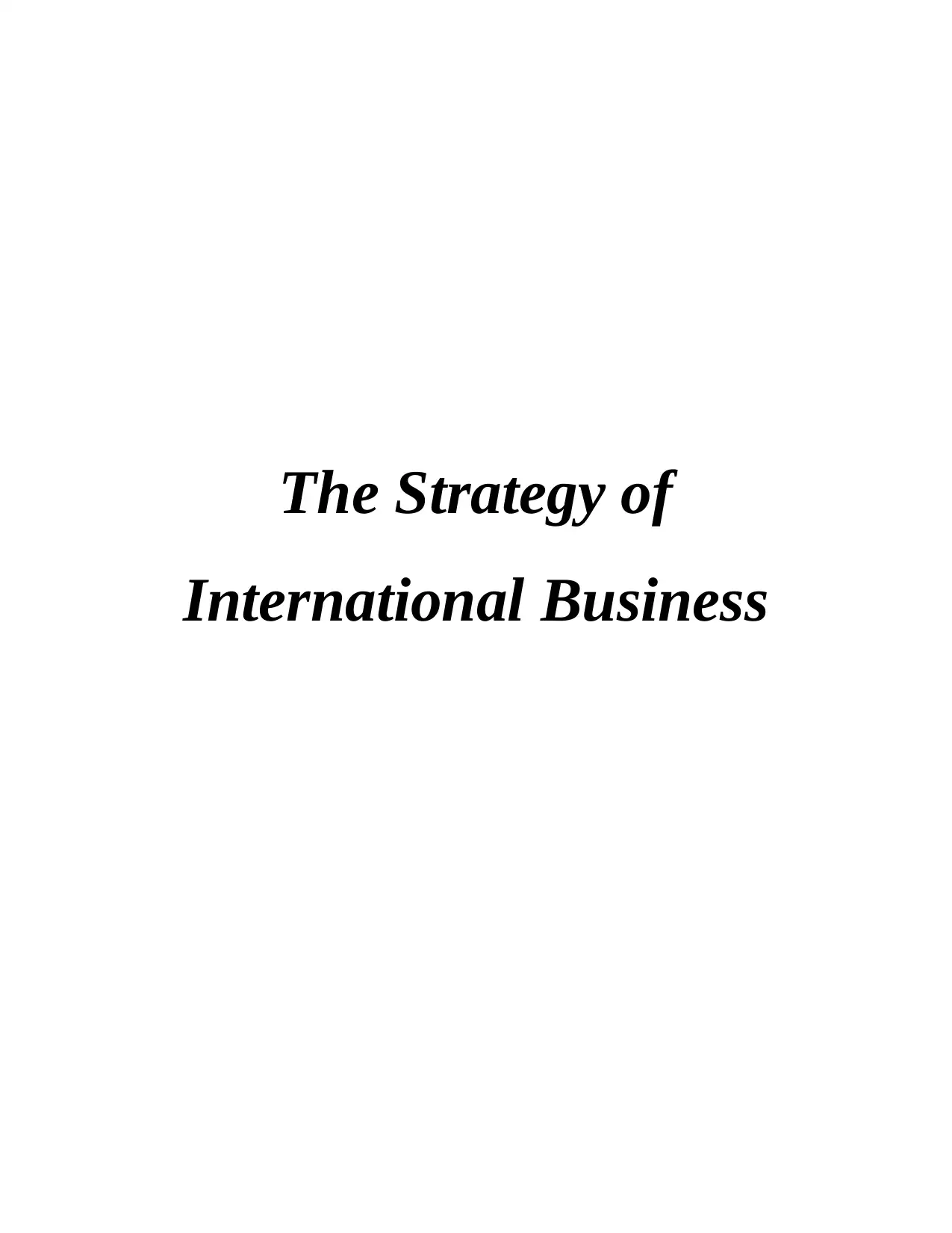
The Strategy of
International Business
International Business
Secure Best Marks with AI Grader
Need help grading? Try our AI Grader for instant feedback on your assignments.
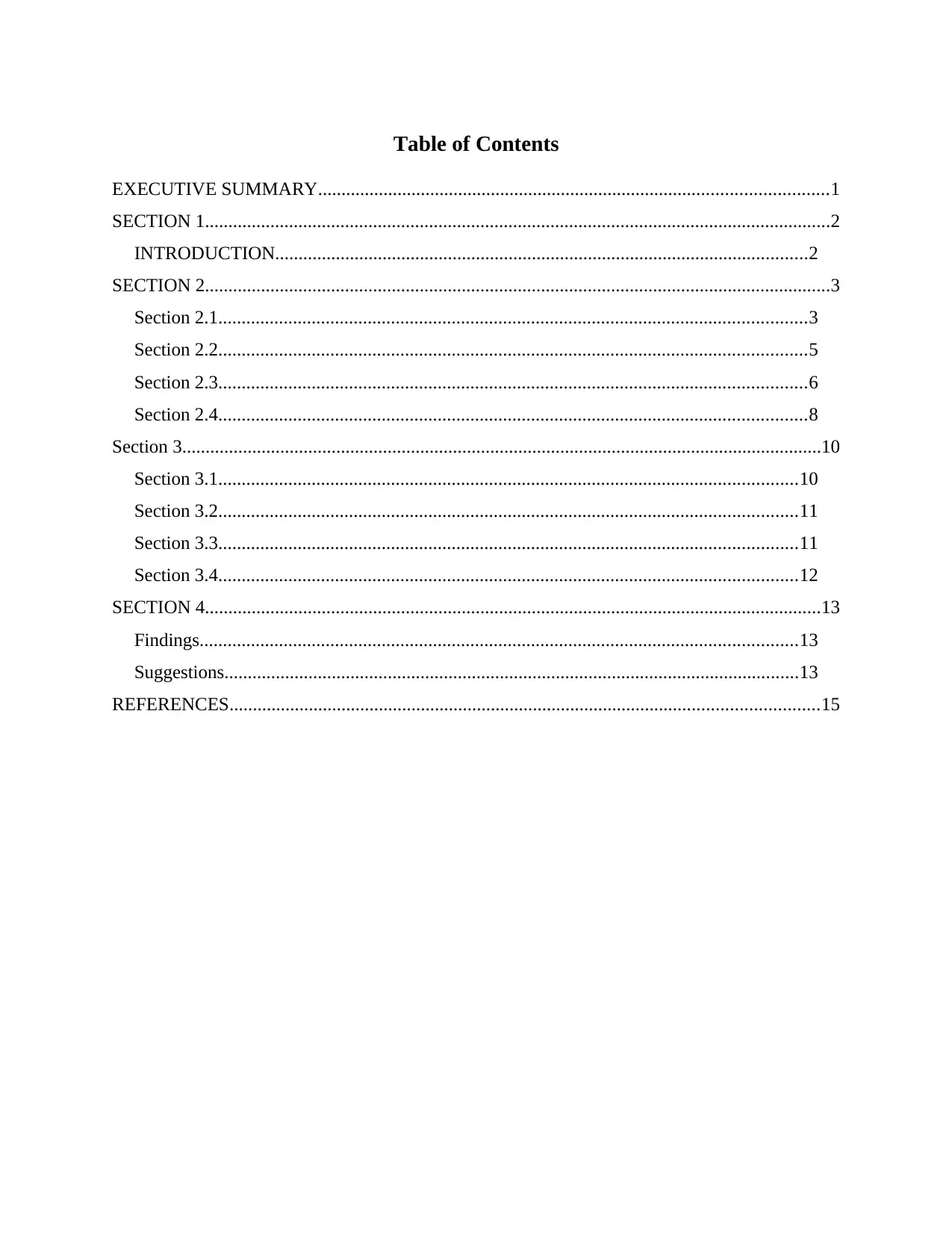
Table of Contents
EXECUTIVE SUMMARY.............................................................................................................1
SECTION 1......................................................................................................................................2
INTRODUCTION..................................................................................................................2
SECTION 2......................................................................................................................................3
Section 2.1..............................................................................................................................3
Section 2.2..............................................................................................................................5
Section 2.3..............................................................................................................................6
Section 2.4..............................................................................................................................8
Section 3.........................................................................................................................................10
Section 3.1............................................................................................................................10
Section 3.2............................................................................................................................11
Section 3.3............................................................................................................................11
Section 3.4............................................................................................................................12
SECTION 4....................................................................................................................................13
Findings................................................................................................................................13
Suggestions...........................................................................................................................13
REFERENCES..............................................................................................................................15
EXECUTIVE SUMMARY.............................................................................................................1
SECTION 1......................................................................................................................................2
INTRODUCTION..................................................................................................................2
SECTION 2......................................................................................................................................3
Section 2.1..............................................................................................................................3
Section 2.2..............................................................................................................................5
Section 2.3..............................................................................................................................6
Section 2.4..............................................................................................................................8
Section 3.........................................................................................................................................10
Section 3.1............................................................................................................................10
Section 3.2............................................................................................................................11
Section 3.3............................................................................................................................11
Section 3.4............................................................................................................................12
SECTION 4....................................................................................................................................13
Findings................................................................................................................................13
Suggestions...........................................................................................................................13
REFERENCES..............................................................................................................................15
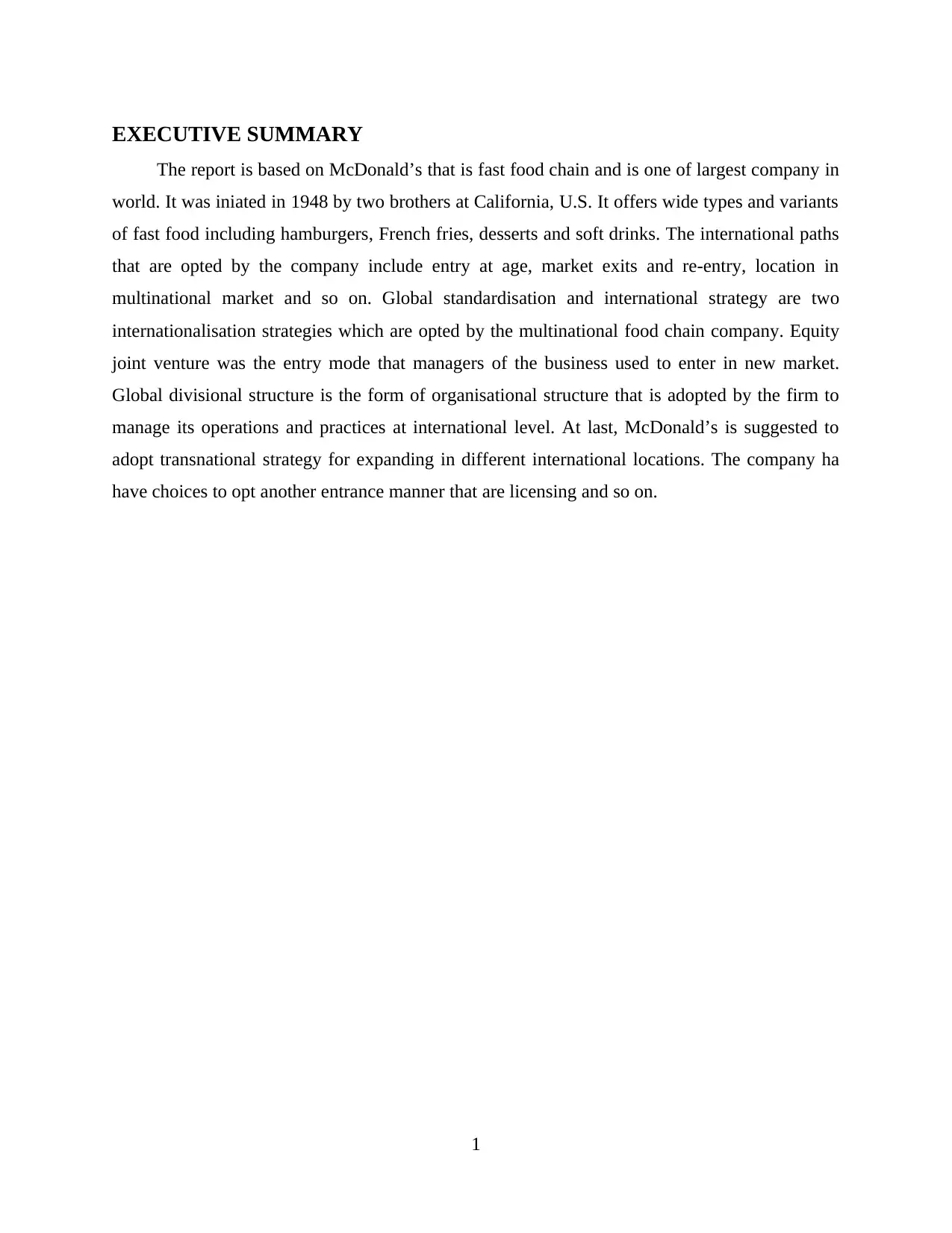
EXECUTIVE SUMMARY
The report is based on McDonald’s that is fast food chain and is one of largest company in
world. It was iniated in 1948 by two brothers at California, U.S. It offers wide types and variants
of fast food including hamburgers, French fries, desserts and soft drinks. The international paths
that are opted by the company include entry at age, market exits and re-entry, location in
multinational market and so on. Global standardisation and international strategy are two
internationalisation strategies which are opted by the multinational food chain company. Equity
joint venture was the entry mode that managers of the business used to enter in new market.
Global divisional structure is the form of organisational structure that is adopted by the firm to
manage its operations and practices at international level. At last, McDonald’s is suggested to
adopt transnational strategy for expanding in different international locations. The company ha
have choices to opt another entrance manner that are licensing and so on.
1
The report is based on McDonald’s that is fast food chain and is one of largest company in
world. It was iniated in 1948 by two brothers at California, U.S. It offers wide types and variants
of fast food including hamburgers, French fries, desserts and soft drinks. The international paths
that are opted by the company include entry at age, market exits and re-entry, location in
multinational market and so on. Global standardisation and international strategy are two
internationalisation strategies which are opted by the multinational food chain company. Equity
joint venture was the entry mode that managers of the business used to enter in new market.
Global divisional structure is the form of organisational structure that is adopted by the firm to
manage its operations and practices at international level. At last, McDonald’s is suggested to
adopt transnational strategy for expanding in different international locations. The company ha
have choices to opt another entrance manner that are licensing and so on.
1
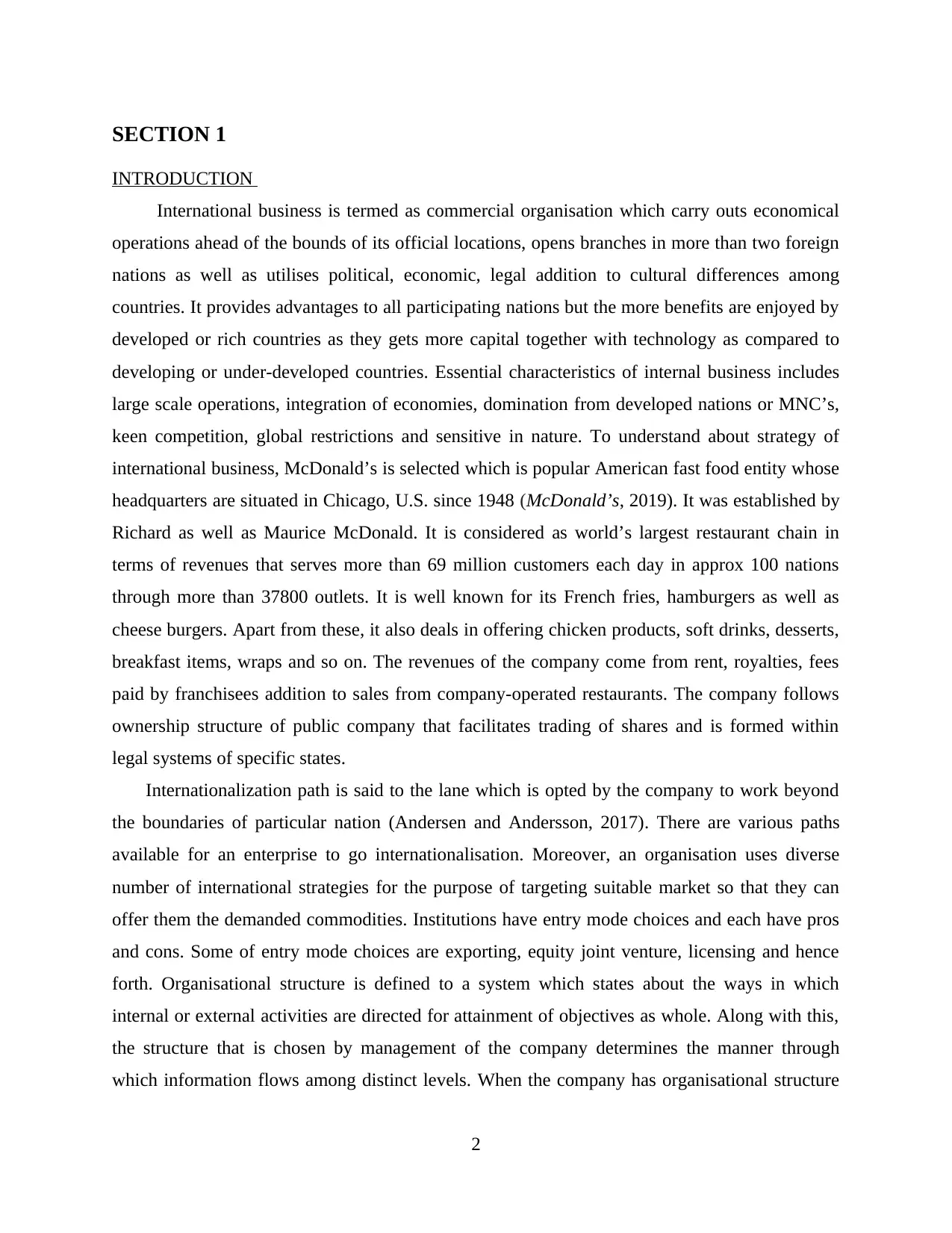
SECTION 1
INTRODUCTION
International business is termed as commercial organisation which carry outs economical
operations ahead of the bounds of its official locations, opens branches in more than two foreign
nations as well as utilises political, economic, legal addition to cultural differences among
countries. It provides advantages to all participating nations but the more benefits are enjoyed by
developed or rich countries as they gets more capital together with technology as compared to
developing or under-developed countries. Essential characteristics of internal business includes
large scale operations, integration of economies, domination from developed nations or MNC’s,
keen competition, global restrictions and sensitive in nature. To understand about strategy of
international business, McDonald’s is selected which is popular American fast food entity whose
headquarters are situated in Chicago, U.S. since 1948 (McDonald’s, 2019). It was established by
Richard as well as Maurice McDonald. It is considered as world’s largest restaurant chain in
terms of revenues that serves more than 69 million customers each day in approx 100 nations
through more than 37800 outlets. It is well known for its French fries, hamburgers as well as
cheese burgers. Apart from these, it also deals in offering chicken products, soft drinks, desserts,
breakfast items, wraps and so on. The revenues of the company come from rent, royalties, fees
paid by franchisees addition to sales from company-operated restaurants. The company follows
ownership structure of public company that facilitates trading of shares and is formed within
legal systems of specific states.
Internationalization path is said to the lane which is opted by the company to work beyond
the boundaries of particular nation (Andersen and Andersson, 2017). There are various paths
available for an enterprise to go internationalisation. Moreover, an organisation uses diverse
number of international strategies for the purpose of targeting suitable market so that they can
offer them the demanded commodities. Institutions have entry mode choices and each have pros
and cons. Some of entry mode choices are exporting, equity joint venture, licensing and hence
forth. Organisational structure is defined to a system which states about the ways in which
internal or external activities are directed for attainment of objectives as whole. Along with this,
the structure that is chosen by management of the company determines the manner through
which information flows among distinct levels. When the company has organisational structure
2
INTRODUCTION
International business is termed as commercial organisation which carry outs economical
operations ahead of the bounds of its official locations, opens branches in more than two foreign
nations as well as utilises political, economic, legal addition to cultural differences among
countries. It provides advantages to all participating nations but the more benefits are enjoyed by
developed or rich countries as they gets more capital together with technology as compared to
developing or under-developed countries. Essential characteristics of internal business includes
large scale operations, integration of economies, domination from developed nations or MNC’s,
keen competition, global restrictions and sensitive in nature. To understand about strategy of
international business, McDonald’s is selected which is popular American fast food entity whose
headquarters are situated in Chicago, U.S. since 1948 (McDonald’s, 2019). It was established by
Richard as well as Maurice McDonald. It is considered as world’s largest restaurant chain in
terms of revenues that serves more than 69 million customers each day in approx 100 nations
through more than 37800 outlets. It is well known for its French fries, hamburgers as well as
cheese burgers. Apart from these, it also deals in offering chicken products, soft drinks, desserts,
breakfast items, wraps and so on. The revenues of the company come from rent, royalties, fees
paid by franchisees addition to sales from company-operated restaurants. The company follows
ownership structure of public company that facilitates trading of shares and is formed within
legal systems of specific states.
Internationalization path is said to the lane which is opted by the company to work beyond
the boundaries of particular nation (Andersen and Andersson, 2017). There are various paths
available for an enterprise to go internationalisation. Moreover, an organisation uses diverse
number of international strategies for the purpose of targeting suitable market so that they can
offer them the demanded commodities. Institutions have entry mode choices and each have pros
and cons. Some of entry mode choices are exporting, equity joint venture, licensing and hence
forth. Organisational structure is defined to a system which states about the ways in which
internal or external activities are directed for attainment of objectives as whole. Along with this,
the structure that is chosen by management of the company determines the manner through
which information flows among distinct levels. When the company has organisational structure
2
Secure Best Marks with AI Grader
Need help grading? Try our AI Grader for instant feedback on your assignments.
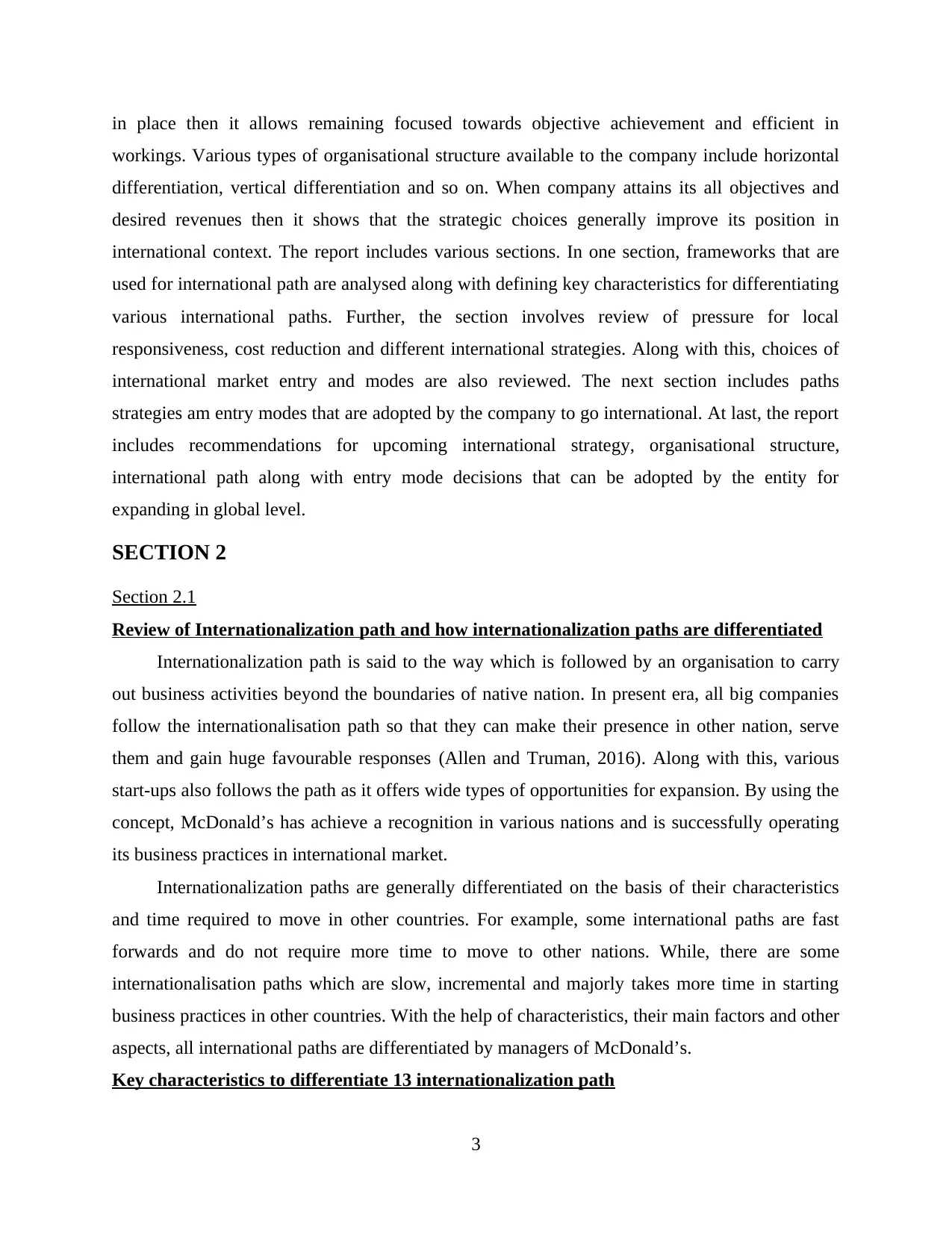
in place then it allows remaining focused towards objective achievement and efficient in
workings. Various types of organisational structure available to the company include horizontal
differentiation, vertical differentiation and so on. When company attains its all objectives and
desired revenues then it shows that the strategic choices generally improve its position in
international context. The report includes various sections. In one section, frameworks that are
used for international path are analysed along with defining key characteristics for differentiating
various international paths. Further, the section involves review of pressure for local
responsiveness, cost reduction and different international strategies. Along with this, choices of
international market entry and modes are also reviewed. The next section includes paths
strategies am entry modes that are adopted by the company to go international. At last, the report
includes recommendations for upcoming international strategy, organisational structure,
international path along with entry mode decisions that can be adopted by the entity for
expanding in global level.
SECTION 2
Section 2.1
Review of Internationalization path and how internationalization paths are differentiated
Internationalization path is said to the way which is followed by an organisation to carry
out business activities beyond the boundaries of native nation. In present era, all big companies
follow the internationalisation path so that they can make their presence in other nation, serve
them and gain huge favourable responses (Allen and Truman, 2016). Along with this, various
start-ups also follows the path as it offers wide types of opportunities for expansion. By using the
concept, McDonald’s has achieve a recognition in various nations and is successfully operating
its business practices in international market.
Internationalization paths are generally differentiated on the basis of their characteristics
and time required to move in other countries. For example, some international paths are fast
forwards and do not require more time to move to other nations. While, there are some
internationalisation paths which are slow, incremental and majorly takes more time in starting
business practices in other countries. With the help of characteristics, their main factors and other
aspects, all international paths are differentiated by managers of McDonald’s.
Key characteristics to differentiate 13 internationalization path
3
workings. Various types of organisational structure available to the company include horizontal
differentiation, vertical differentiation and so on. When company attains its all objectives and
desired revenues then it shows that the strategic choices generally improve its position in
international context. The report includes various sections. In one section, frameworks that are
used for international path are analysed along with defining key characteristics for differentiating
various international paths. Further, the section involves review of pressure for local
responsiveness, cost reduction and different international strategies. Along with this, choices of
international market entry and modes are also reviewed. The next section includes paths
strategies am entry modes that are adopted by the company to go international. At last, the report
includes recommendations for upcoming international strategy, organisational structure,
international path along with entry mode decisions that can be adopted by the entity for
expanding in global level.
SECTION 2
Section 2.1
Review of Internationalization path and how internationalization paths are differentiated
Internationalization path is said to the way which is followed by an organisation to carry
out business activities beyond the boundaries of native nation. In present era, all big companies
follow the internationalisation path so that they can make their presence in other nation, serve
them and gain huge favourable responses (Allen and Truman, 2016). Along with this, various
start-ups also follows the path as it offers wide types of opportunities for expansion. By using the
concept, McDonald’s has achieve a recognition in various nations and is successfully operating
its business practices in international market.
Internationalization paths are generally differentiated on the basis of their characteristics
and time required to move in other countries. For example, some international paths are fast
forwards and do not require more time to move to other nations. While, there are some
internationalisation paths which are slow, incremental and majorly takes more time in starting
business practices in other countries. With the help of characteristics, their main factors and other
aspects, all international paths are differentiated by managers of McDonald’s.
Key characteristics to differentiate 13 internationalization path
3
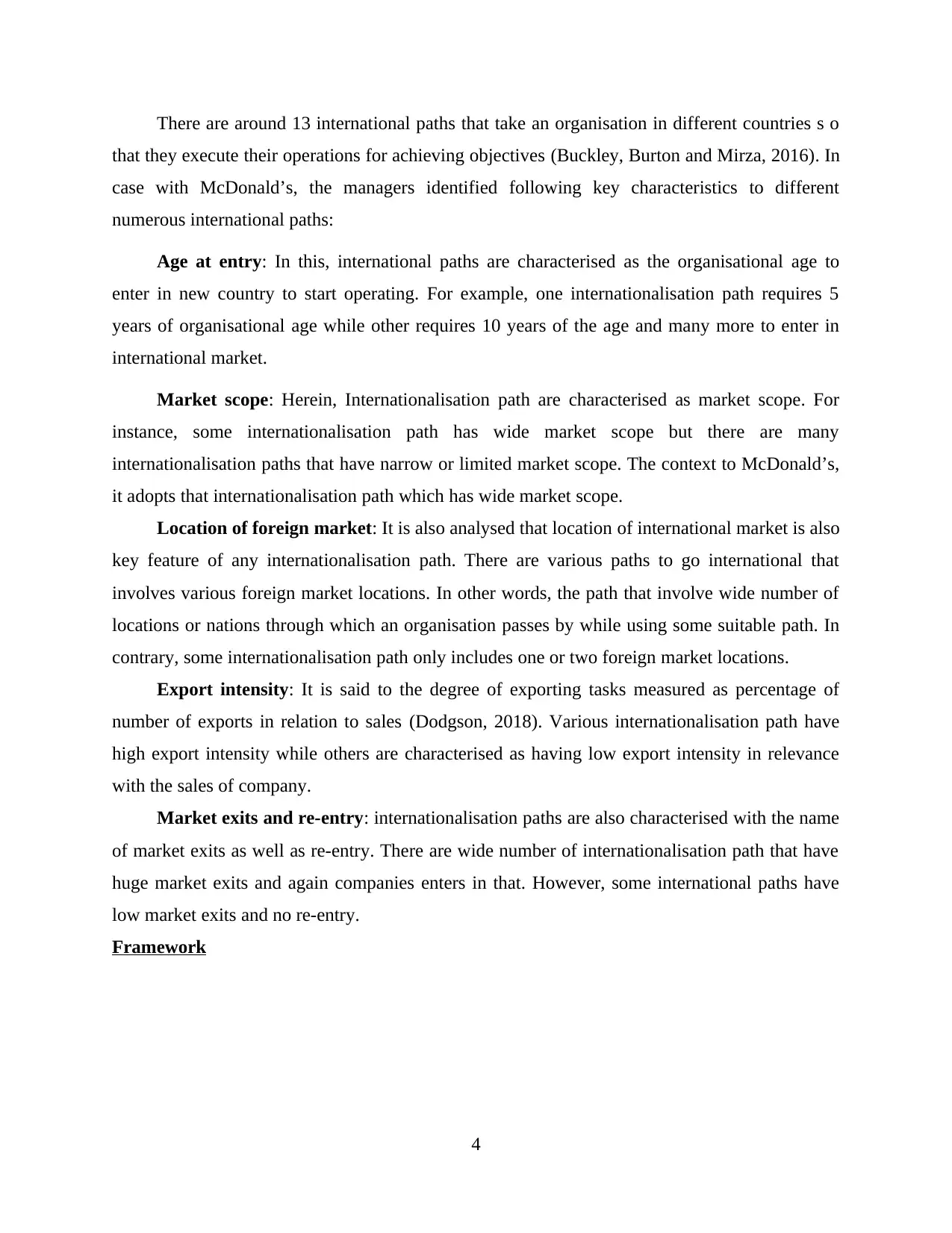
There are around 13 international paths that take an organisation in different countries s o
that they execute their operations for achieving objectives (Buckley, Burton and Mirza, 2016). In
case with McDonald’s, the managers identified following key characteristics to different
numerous international paths:
Age at entry: In this, international paths are characterised as the organisational age to
enter in new country to start operating. For example, one internationalisation path requires 5
years of organisational age while other requires 10 years of the age and many more to enter in
international market.
Market scope: Herein, Internationalisation path are characterised as market scope. For
instance, some internationalisation path has wide market scope but there are many
internationalisation paths that have narrow or limited market scope. The context to McDonald’s,
it adopts that internationalisation path which has wide market scope.
Location of foreign market: It is also analysed that location of international market is also
key feature of any internationalisation path. There are various paths to go international that
involves various foreign market locations. In other words, the path that involve wide number of
locations or nations through which an organisation passes by while using some suitable path. In
contrary, some internationalisation path only includes one or two foreign market locations.
Export intensity: It is said to the degree of exporting tasks measured as percentage of
number of exports in relation to sales (Dodgson, 2018). Various internationalisation path have
high export intensity while others are characterised as having low export intensity in relevance
with the sales of company.
Market exits and re-entry: internationalisation paths are also characterised with the name
of market exits as well as re-entry. There are wide number of internationalisation path that have
huge market exits and again companies enters in that. However, some international paths have
low market exits and no re-entry.
Framework
4
that they execute their operations for achieving objectives (Buckley, Burton and Mirza, 2016). In
case with McDonald’s, the managers identified following key characteristics to different
numerous international paths:
Age at entry: In this, international paths are characterised as the organisational age to
enter in new country to start operating. For example, one internationalisation path requires 5
years of organisational age while other requires 10 years of the age and many more to enter in
international market.
Market scope: Herein, Internationalisation path are characterised as market scope. For
instance, some internationalisation path has wide market scope but there are many
internationalisation paths that have narrow or limited market scope. The context to McDonald’s,
it adopts that internationalisation path which has wide market scope.
Location of foreign market: It is also analysed that location of international market is also
key feature of any internationalisation path. There are various paths to go international that
involves various foreign market locations. In other words, the path that involve wide number of
locations or nations through which an organisation passes by while using some suitable path. In
contrary, some internationalisation path only includes one or two foreign market locations.
Export intensity: It is said to the degree of exporting tasks measured as percentage of
number of exports in relation to sales (Dodgson, 2018). Various internationalisation path have
high export intensity while others are characterised as having low export intensity in relevance
with the sales of company.
Market exits and re-entry: internationalisation paths are also characterised with the name
of market exits as well as re-entry. There are wide number of internationalisation path that have
huge market exits and again companies enters in that. However, some international paths have
low market exits and no re-entry.
Framework
4
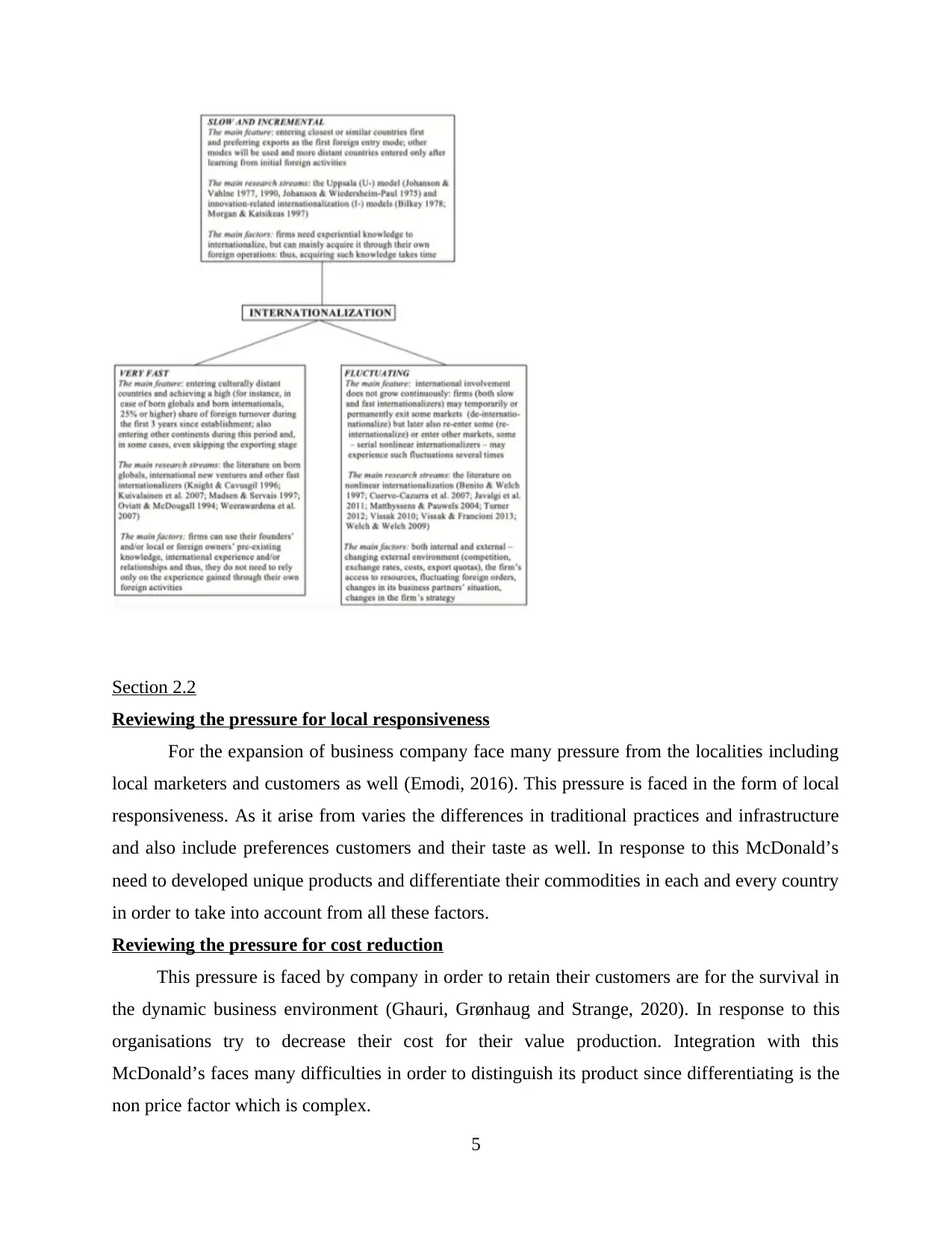
Section 2.2
Reviewing the pressure for local responsiveness
For the expansion of business company face many pressure from the localities including
local marketers and customers as well (Emodi, 2016). This pressure is faced in the form of local
responsiveness. As it arise from varies the differences in traditional practices and infrastructure
and also include preferences customers and their taste as well. In response to this McDonald’s
need to developed unique products and differentiate their commodities in each and every country
in order to take into account from all these factors.
Reviewing the pressure for cost reduction
This pressure is faced by company in order to retain their customers are for the survival in
the dynamic business environment (Ghauri, Grønhaug and Strange, 2020). In response to this
organisations try to decrease their cost for their value production. Integration with this
McDonald’s faces many difficulties in order to distinguish its product since differentiating is the
non price factor which is complex.
5
Reviewing the pressure for local responsiveness
For the expansion of business company face many pressure from the localities including
local marketers and customers as well (Emodi, 2016). This pressure is faced in the form of local
responsiveness. As it arise from varies the differences in traditional practices and infrastructure
and also include preferences customers and their taste as well. In response to this McDonald’s
need to developed unique products and differentiate their commodities in each and every country
in order to take into account from all these factors.
Reviewing the pressure for cost reduction
This pressure is faced by company in order to retain their customers are for the survival in
the dynamic business environment (Ghauri, Grønhaug and Strange, 2020). In response to this
organisations try to decrease their cost for their value production. Integration with this
McDonald’s faces many difficulties in order to distinguish its product since differentiating is the
non price factor which is complex.
5
Paraphrase This Document
Need a fresh take? Get an instant paraphrase of this document with our AI Paraphraser
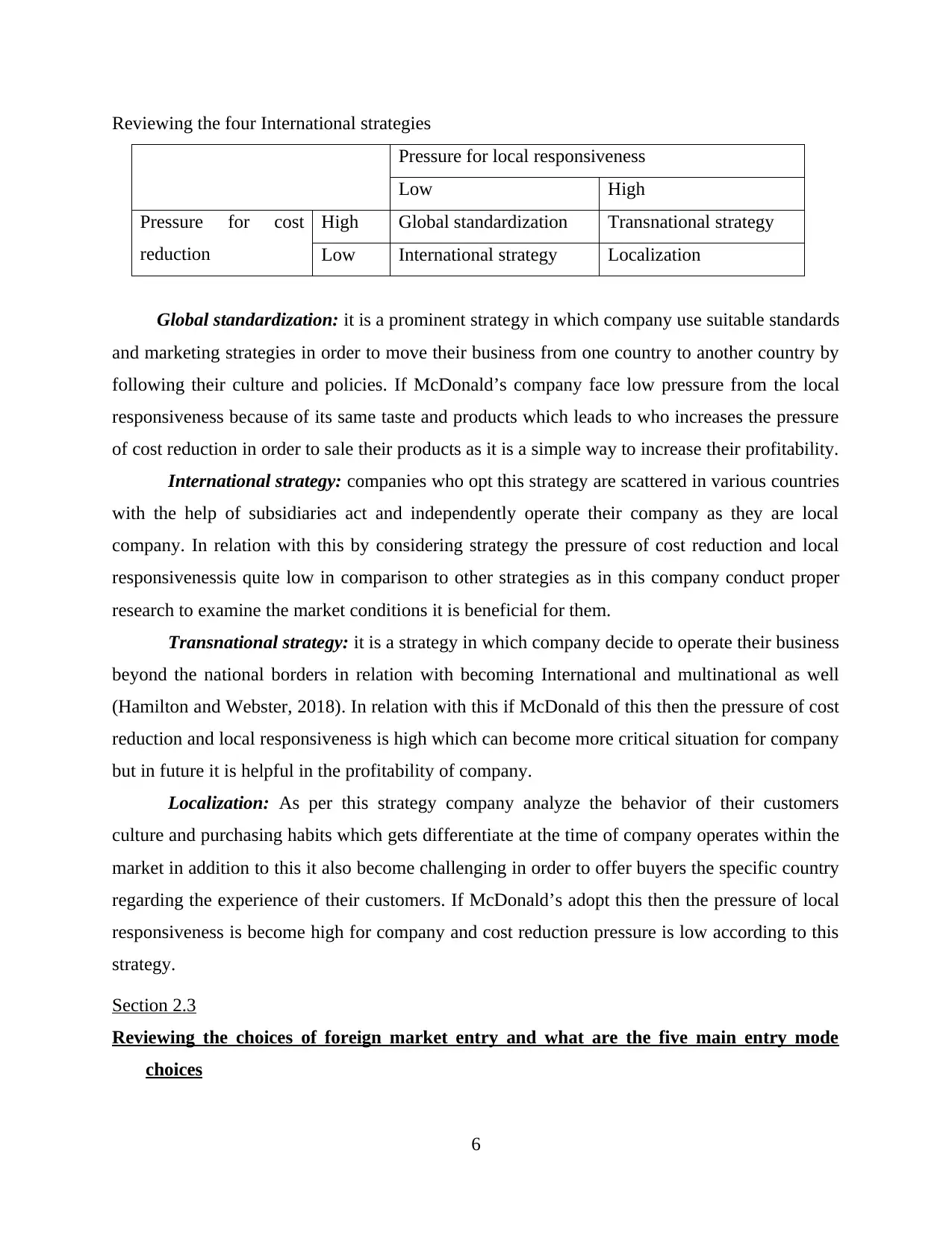
Reviewing the four International strategies
Pressure for local responsiveness
Low High
Pressure for cost
reduction
High Global standardization Transnational strategy
Low International strategy Localization
Global standardization: it is a prominent strategy in which company use suitable standards
and marketing strategies in order to move their business from one country to another country by
following their culture and policies. If McDonald’s company face low pressure from the local
responsiveness because of its same taste and products which leads to who increases the pressure
of cost reduction in order to sale their products as it is a simple way to increase their profitability.
International strategy: companies who opt this strategy are scattered in various countries
with the help of subsidiaries act and independently operate their company as they are local
company. In relation with this by considering strategy the pressure of cost reduction and local
responsivenessis quite low in comparison to other strategies as in this company conduct proper
research to examine the market conditions it is beneficial for them.
Transnational strategy: it is a strategy in which company decide to operate their business
beyond the national borders in relation with becoming International and multinational as well
(Hamilton and Webster, 2018). In relation with this if McDonald of this then the pressure of cost
reduction and local responsiveness is high which can become more critical situation for company
but in future it is helpful in the profitability of company.
Localization: As per this strategy company analyze the behavior of their customers
culture and purchasing habits which gets differentiate at the time of company operates within the
market in addition to this it also become challenging in order to offer buyers the specific country
regarding the experience of their customers. If McDonald’s adopt this then the pressure of local
responsiveness is become high for company and cost reduction pressure is low according to this
strategy.
Section 2.3
Reviewing the choices of foreign market entry and what are the five main entry mode
choices
6
Pressure for local responsiveness
Low High
Pressure for cost
reduction
High Global standardization Transnational strategy
Low International strategy Localization
Global standardization: it is a prominent strategy in which company use suitable standards
and marketing strategies in order to move their business from one country to another country by
following their culture and policies. If McDonald’s company face low pressure from the local
responsiveness because of its same taste and products which leads to who increases the pressure
of cost reduction in order to sale their products as it is a simple way to increase their profitability.
International strategy: companies who opt this strategy are scattered in various countries
with the help of subsidiaries act and independently operate their company as they are local
company. In relation with this by considering strategy the pressure of cost reduction and local
responsivenessis quite low in comparison to other strategies as in this company conduct proper
research to examine the market conditions it is beneficial for them.
Transnational strategy: it is a strategy in which company decide to operate their business
beyond the national borders in relation with becoming International and multinational as well
(Hamilton and Webster, 2018). In relation with this if McDonald of this then the pressure of cost
reduction and local responsiveness is high which can become more critical situation for company
but in future it is helpful in the profitability of company.
Localization: As per this strategy company analyze the behavior of their customers
culture and purchasing habits which gets differentiate at the time of company operates within the
market in addition to this it also become challenging in order to offer buyers the specific country
regarding the experience of their customers. If McDonald’s adopt this then the pressure of local
responsiveness is become high for company and cost reduction pressure is low according to this
strategy.
Section 2.3
Reviewing the choices of foreign market entry and what are the five main entry mode
choices
6
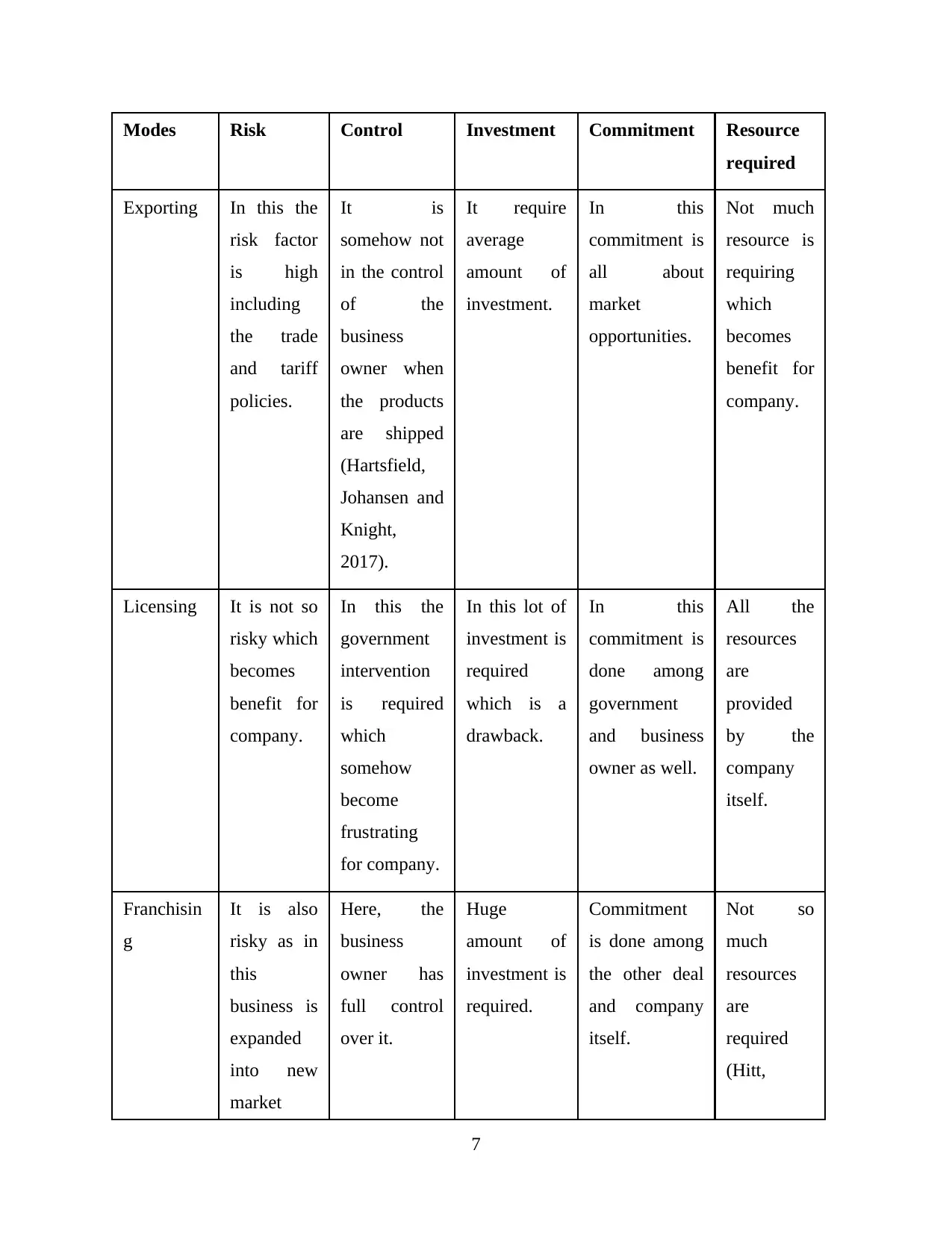
Modes Risk Control Investment Commitment Resource
required
Exporting In this the
risk factor
is high
including
the trade
and tariff
policies.
It is
somehow not
in the control
of the
business
owner when
the products
are shipped
(Hartsfield,
Johansen and
Knight,
2017).
It require
average
amount of
investment.
In this
commitment is
all about
market
opportunities.
Not much
resource is
requiring
which
becomes
benefit for
company.
Licensing It is not so
risky which
becomes
benefit for
company.
In this the
government
intervention
is required
which
somehow
become
frustrating
for company.
In this lot of
investment is
required
which is a
drawback.
In this
commitment is
done among
government
and business
owner as well.
All the
resources
are
provided
by the
company
itself.
Franchisin
g
It is also
risky as in
this
business is
expanded
into new
market
Here, the
business
owner has
full control
over it.
Huge
amount of
investment is
required.
Commitment
is done among
the other deal
and company
itself.
Not so
much
resources
are
required
(Hitt,
7
required
Exporting In this the
risk factor
is high
including
the trade
and tariff
policies.
It is
somehow not
in the control
of the
business
owner when
the products
are shipped
(Hartsfield,
Johansen and
Knight,
2017).
It require
average
amount of
investment.
In this
commitment is
all about
market
opportunities.
Not much
resource is
requiring
which
becomes
benefit for
company.
Licensing It is not so
risky which
becomes
benefit for
company.
In this the
government
intervention
is required
which
somehow
become
frustrating
for company.
In this lot of
investment is
required
which is a
drawback.
In this
commitment is
done among
government
and business
owner as well.
All the
resources
are
provided
by the
company
itself.
Franchisin
g
It is also
risky as in
this
business is
expanded
into new
market
Here, the
business
owner has
full control
over it.
Huge
amount of
investment is
required.
Commitment
is done among
the other deal
and company
itself.
Not so
much
resources
are
required
(Hitt,
7
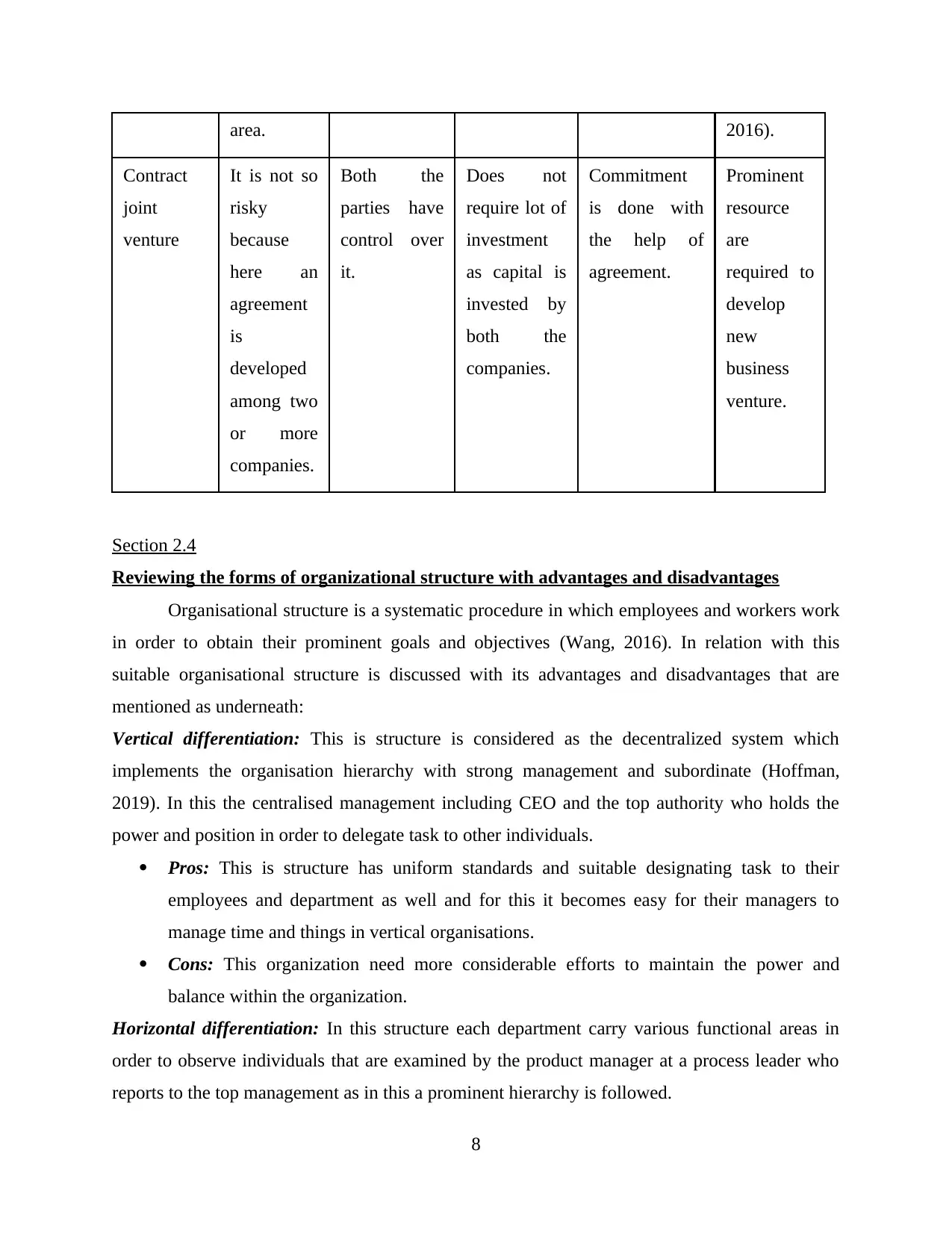
area. 2016).
Contract
joint
venture
It is not so
risky
because
here an
agreement
is
developed
among two
or more
companies.
Both the
parties have
control over
it.
Does not
require lot of
investment
as capital is
invested by
both the
companies.
Commitment
is done with
the help of
agreement.
Prominent
resource
are
required to
develop
new
business
venture.
Section 2.4
Reviewing the forms of organizational structure with advantages and disadvantages
Organisational structure is a systematic procedure in which employees and workers work
in order to obtain their prominent goals and objectives (Wang, 2016). In relation with this
suitable organisational structure is discussed with its advantages and disadvantages that are
mentioned as underneath:
Vertical differentiation: This is structure is considered as the decentralized system which
implements the organisation hierarchy with strong management and subordinate (Hoffman,
2019). In this the centralised management including CEO and the top authority who holds the
power and position in order to delegate task to other individuals.
Pros: This is structure has uniform standards and suitable designating task to their
employees and department as well and for this it becomes easy for their managers to
manage time and things in vertical organisations.
Cons: This organization need more considerable efforts to maintain the power and
balance within the organization.
Horizontal differentiation: In this structure each department carry various functional areas in
order to observe individuals that are examined by the product manager at a process leader who
reports to the top management as in this a prominent hierarchy is followed.
8
Contract
joint
venture
It is not so
risky
because
here an
agreement
is
developed
among two
or more
companies.
Both the
parties have
control over
it.
Does not
require lot of
investment
as capital is
invested by
both the
companies.
Commitment
is done with
the help of
agreement.
Prominent
resource
are
required to
develop
new
business
venture.
Section 2.4
Reviewing the forms of organizational structure with advantages and disadvantages
Organisational structure is a systematic procedure in which employees and workers work
in order to obtain their prominent goals and objectives (Wang, 2016). In relation with this
suitable organisational structure is discussed with its advantages and disadvantages that are
mentioned as underneath:
Vertical differentiation: This is structure is considered as the decentralized system which
implements the organisation hierarchy with strong management and subordinate (Hoffman,
2019). In this the centralised management including CEO and the top authority who holds the
power and position in order to delegate task to other individuals.
Pros: This is structure has uniform standards and suitable designating task to their
employees and department as well and for this it becomes easy for their managers to
manage time and things in vertical organisations.
Cons: This organization need more considerable efforts to maintain the power and
balance within the organization.
Horizontal differentiation: In this structure each department carry various functional areas in
order to observe individuals that are examined by the product manager at a process leader who
reports to the top management as in this a prominent hierarchy is followed.
8
Secure Best Marks with AI Grader
Need help grading? Try our AI Grader for instant feedback on your assignments.
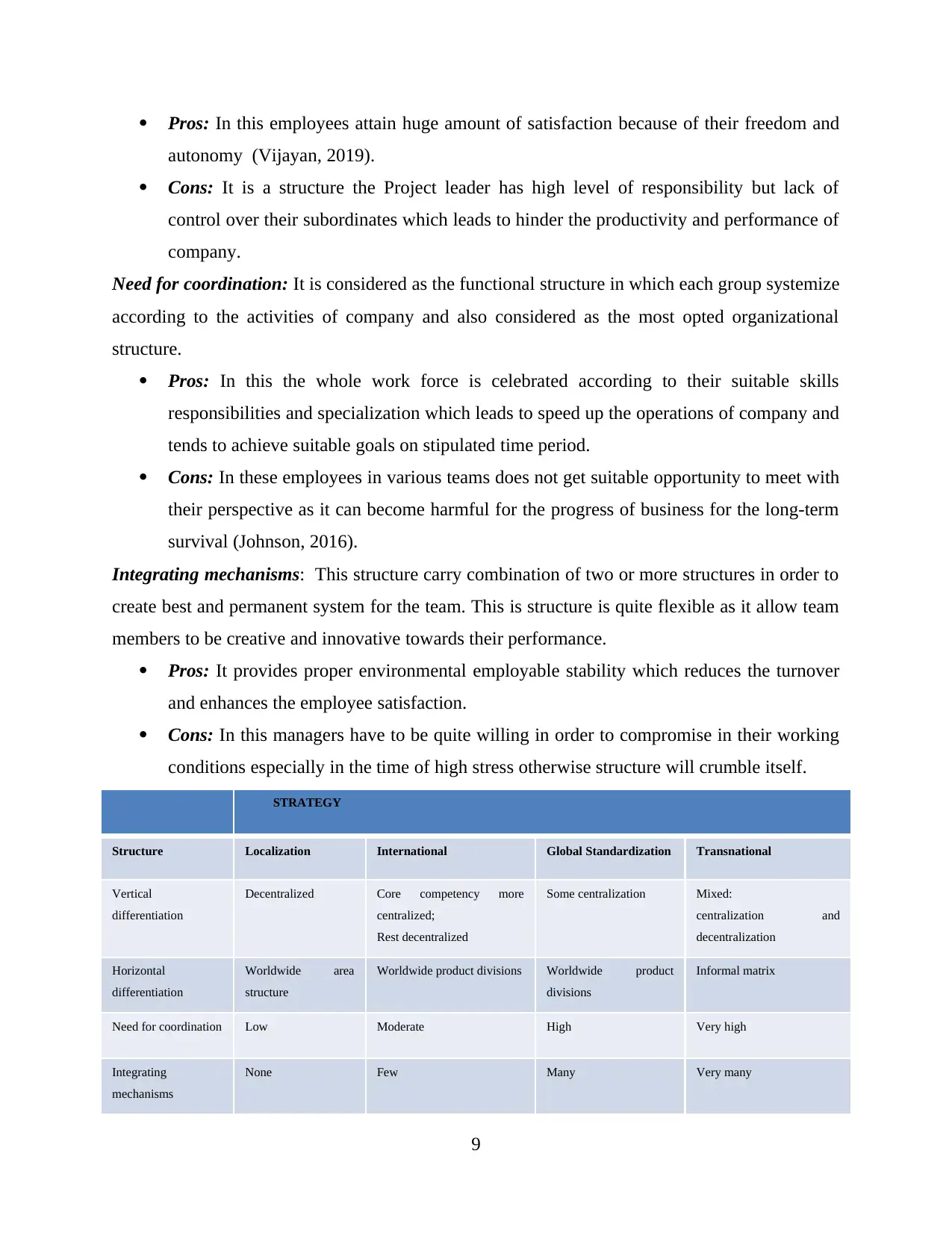
Pros: In this employees attain huge amount of satisfaction because of their freedom and
autonomy (Vijayan, 2019).
Cons: It is a structure the Project leader has high level of responsibility but lack of
control over their subordinates which leads to hinder the productivity and performance of
company.
Need for coordination: It is considered as the functional structure in which each group systemize
according to the activities of company and also considered as the most opted organizational
structure.
Pros: In this the whole work force is celebrated according to their suitable skills
responsibilities and specialization which leads to speed up the operations of company and
tends to achieve suitable goals on stipulated time period.
Cons: In these employees in various teams does not get suitable opportunity to meet with
their perspective as it can become harmful for the progress of business for the long-term
survival (Johnson, 2016).
Integrating mechanisms: This structure carry combination of two or more structures in order to
create best and permanent system for the team. This is structure is quite flexible as it allow team
members to be creative and innovative towards their performance.
Pros: It provides proper environmental employable stability which reduces the turnover
and enhances the employee satisfaction.
Cons: In this managers have to be quite willing in order to compromise in their working
conditions especially in the time of high stress otherwise structure will crumble itself.
STRATEGY
Structure Localization International Global Standardization Transnational
Vertical
differentiation
Decentralized Core competency more
centralized;
Rest decentralized
Some centralization Mixed:
centralization and
decentralization
Horizontal
differentiation
Worldwide area
structure
Worldwide product divisions Worldwide product
divisions
Informal matrix
Need for coordination Low Moderate High Very high
Integrating
mechanisms
None Few Many Very many
9
autonomy (Vijayan, 2019).
Cons: It is a structure the Project leader has high level of responsibility but lack of
control over their subordinates which leads to hinder the productivity and performance of
company.
Need for coordination: It is considered as the functional structure in which each group systemize
according to the activities of company and also considered as the most opted organizational
structure.
Pros: In this the whole work force is celebrated according to their suitable skills
responsibilities and specialization which leads to speed up the operations of company and
tends to achieve suitable goals on stipulated time period.
Cons: In these employees in various teams does not get suitable opportunity to meet with
their perspective as it can become harmful for the progress of business for the long-term
survival (Johnson, 2016).
Integrating mechanisms: This structure carry combination of two or more structures in order to
create best and permanent system for the team. This is structure is quite flexible as it allow team
members to be creative and innovative towards their performance.
Pros: It provides proper environmental employable stability which reduces the turnover
and enhances the employee satisfaction.
Cons: In this managers have to be quite willing in order to compromise in their working
conditions especially in the time of high stress otherwise structure will crumble itself.
STRATEGY
Structure Localization International Global Standardization Transnational
Vertical
differentiation
Decentralized Core competency more
centralized;
Rest decentralized
Some centralization Mixed:
centralization and
decentralization
Horizontal
differentiation
Worldwide area
structure
Worldwide product divisions Worldwide product
divisions
Informal matrix
Need for coordination Low Moderate High Very high
Integrating
mechanisms
None Few Many Very many
9
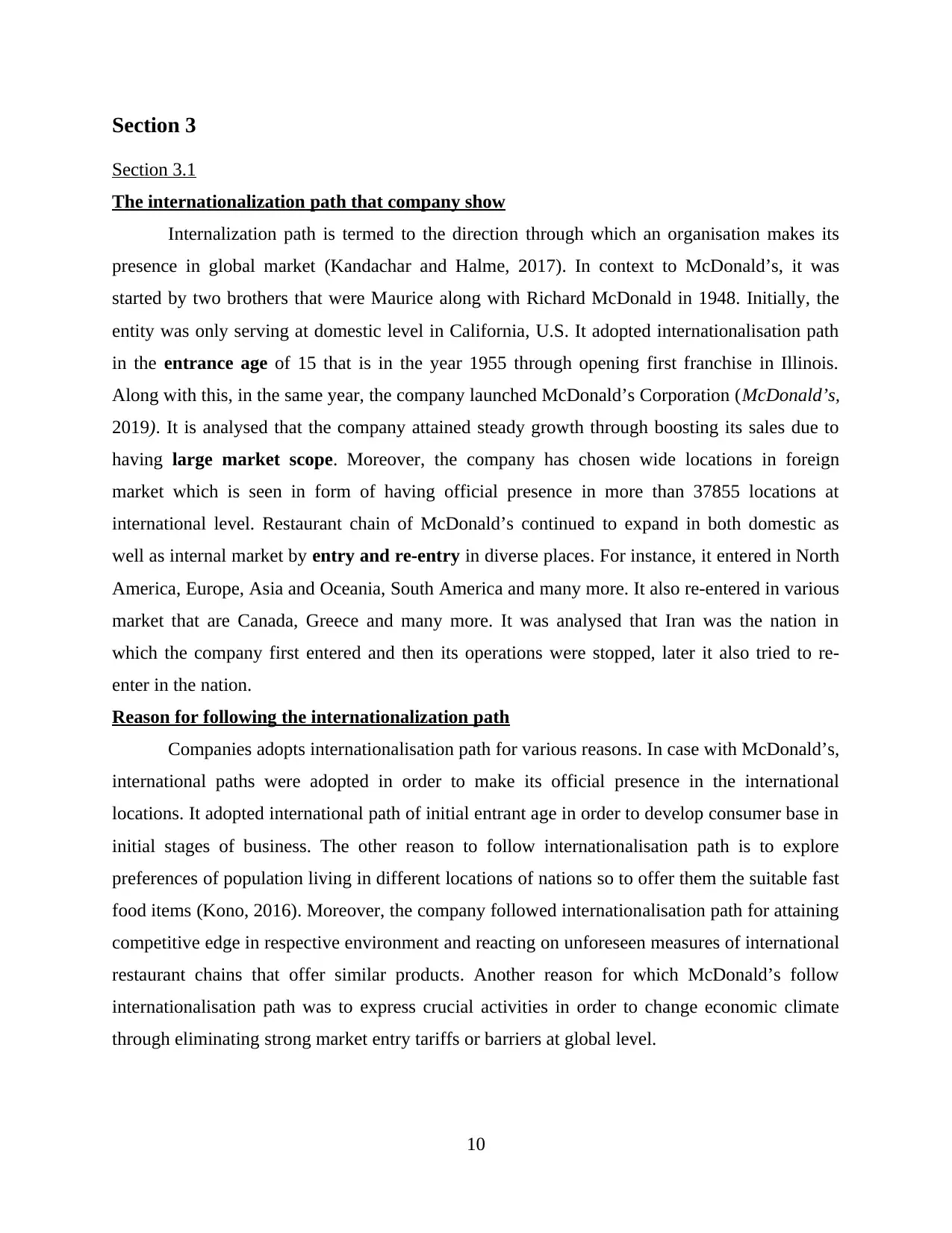
Section 3
Section 3.1
The internationalization path that company show
Internalization path is termed to the direction through which an organisation makes its
presence in global market (Kandachar and Halme, 2017). In context to McDonald’s, it was
started by two brothers that were Maurice along with Richard McDonald in 1948. Initially, the
entity was only serving at domestic level in California, U.S. It adopted internationalisation path
in the entrance age of 15 that is in the year 1955 through opening first franchise in Illinois.
Along with this, in the same year, the company launched McDonald’s Corporation (McDonald’s,
2019). It is analysed that the company attained steady growth through boosting its sales due to
having large market scope. Moreover, the company has chosen wide locations in foreign
market which is seen in form of having official presence in more than 37855 locations at
international level. Restaurant chain of McDonald’s continued to expand in both domestic as
well as internal market by entry and re-entry in diverse places. For instance, it entered in North
America, Europe, Asia and Oceania, South America and many more. It also re-entered in various
market that are Canada, Greece and many more. It was analysed that Iran was the nation in
which the company first entered and then its operations were stopped, later it also tried to re-
enter in the nation.
Reason for following the internationalization path
Companies adopts internationalisation path for various reasons. In case with McDonald’s,
international paths were adopted in order to make its official presence in the international
locations. It adopted international path of initial entrant age in order to develop consumer base in
initial stages of business. The other reason to follow internationalisation path is to explore
preferences of population living in different locations of nations so to offer them the suitable fast
food items (Kono, 2016). Moreover, the company followed internationalisation path for attaining
competitive edge in respective environment and reacting on unforeseen measures of international
restaurant chains that offer similar products. Another reason for which McDonald’s follow
internationalisation path was to express crucial activities in order to change economic climate
through eliminating strong market entry tariffs or barriers at global level.
10
Section 3.1
The internationalization path that company show
Internalization path is termed to the direction through which an organisation makes its
presence in global market (Kandachar and Halme, 2017). In context to McDonald’s, it was
started by two brothers that were Maurice along with Richard McDonald in 1948. Initially, the
entity was only serving at domestic level in California, U.S. It adopted internationalisation path
in the entrance age of 15 that is in the year 1955 through opening first franchise in Illinois.
Along with this, in the same year, the company launched McDonald’s Corporation (McDonald’s,
2019). It is analysed that the company attained steady growth through boosting its sales due to
having large market scope. Moreover, the company has chosen wide locations in foreign
market which is seen in form of having official presence in more than 37855 locations at
international level. Restaurant chain of McDonald’s continued to expand in both domestic as
well as internal market by entry and re-entry in diverse places. For instance, it entered in North
America, Europe, Asia and Oceania, South America and many more. It also re-entered in various
market that are Canada, Greece and many more. It was analysed that Iran was the nation in
which the company first entered and then its operations were stopped, later it also tried to re-
enter in the nation.
Reason for following the internationalization path
Companies adopts internationalisation path for various reasons. In case with McDonald’s,
international paths were adopted in order to make its official presence in the international
locations. It adopted international path of initial entrant age in order to develop consumer base in
initial stages of business. The other reason to follow internationalisation path is to explore
preferences of population living in different locations of nations so to offer them the suitable fast
food items (Kono, 2016). Moreover, the company followed internationalisation path for attaining
competitive edge in respective environment and reacting on unforeseen measures of international
restaurant chains that offer similar products. Another reason for which McDonald’s follow
internationalisation path was to express crucial activities in order to change economic climate
through eliminating strong market entry tariffs or barriers at global level.
10
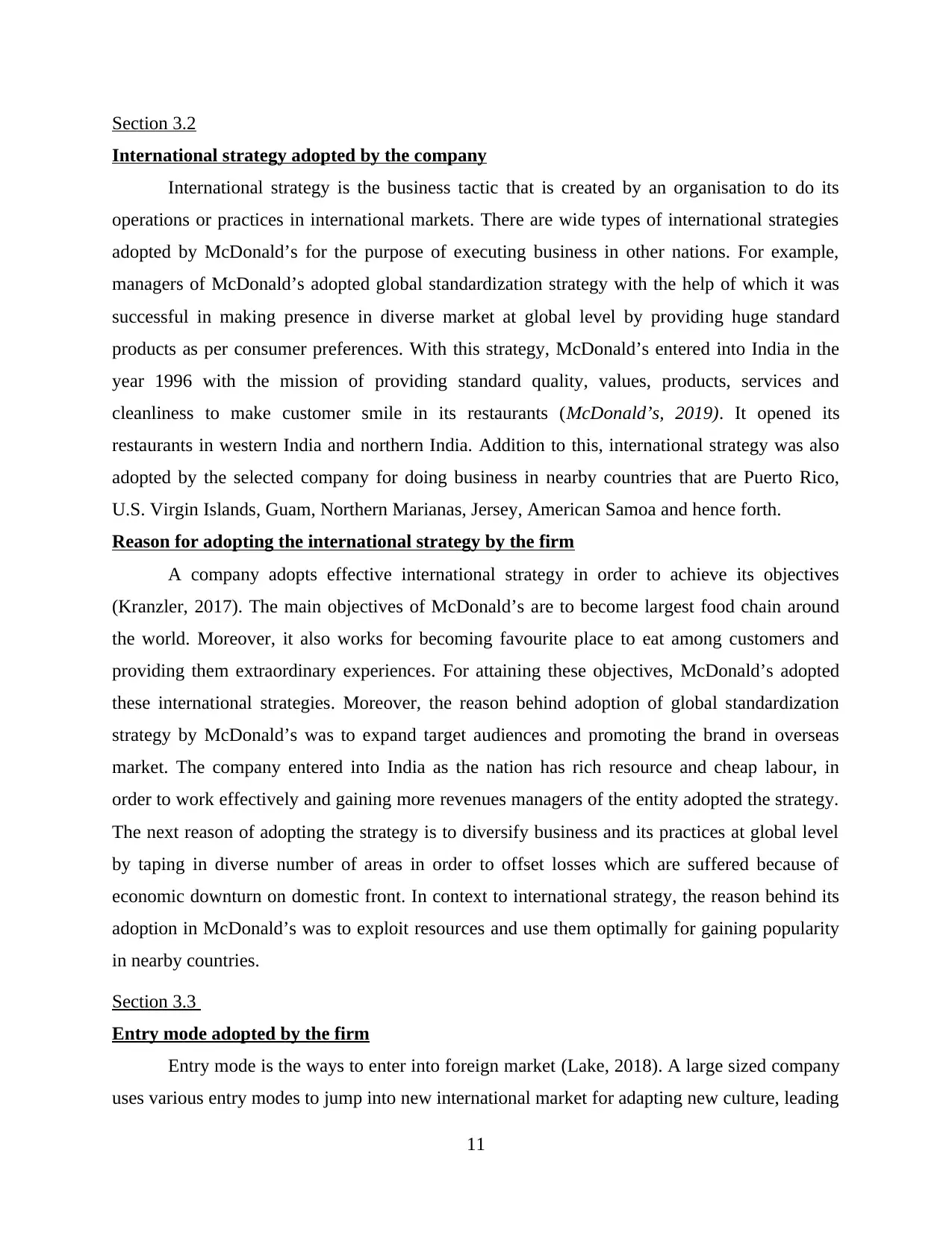
Section 3.2
International strategy adopted by the company
International strategy is the business tactic that is created by an organisation to do its
operations or practices in international markets. There are wide types of international strategies
adopted by McDonald’s for the purpose of executing business in other nations. For example,
managers of McDonald’s adopted global standardization strategy with the help of which it was
successful in making presence in diverse market at global level by providing huge standard
products as per consumer preferences. With this strategy, McDonald’s entered into India in the
year 1996 with the mission of providing standard quality, values, products, services and
cleanliness to make customer smile in its restaurants (McDonald’s, 2019). It opened its
restaurants in western India and northern India. Addition to this, international strategy was also
adopted by the selected company for doing business in nearby countries that are Puerto Rico,
U.S. Virgin Islands, Guam, Northern Marianas, Jersey, American Samoa and hence forth.
Reason for adopting the international strategy by the firm
A company adopts effective international strategy in order to achieve its objectives
(Kranzler, 2017). The main objectives of McDonald’s are to become largest food chain around
the world. Moreover, it also works for becoming favourite place to eat among customers and
providing them extraordinary experiences. For attaining these objectives, McDonald’s adopted
these international strategies. Moreover, the reason behind adoption of global standardization
strategy by McDonald’s was to expand target audiences and promoting the brand in overseas
market. The company entered into India as the nation has rich resource and cheap labour, in
order to work effectively and gaining more revenues managers of the entity adopted the strategy.
The next reason of adopting the strategy is to diversify business and its practices at global level
by taping in diverse number of areas in order to offset losses which are suffered because of
economic downturn on domestic front. In context to international strategy, the reason behind its
adoption in McDonald’s was to exploit resources and use them optimally for gaining popularity
in nearby countries.
Section 3.3
Entry mode adopted by the firm
Entry mode is the ways to enter into foreign market (Lake, 2018). A large sized company
uses various entry modes to jump into new international market for adapting new culture, leading
11
International strategy adopted by the company
International strategy is the business tactic that is created by an organisation to do its
operations or practices in international markets. There are wide types of international strategies
adopted by McDonald’s for the purpose of executing business in other nations. For example,
managers of McDonald’s adopted global standardization strategy with the help of which it was
successful in making presence in diverse market at global level by providing huge standard
products as per consumer preferences. With this strategy, McDonald’s entered into India in the
year 1996 with the mission of providing standard quality, values, products, services and
cleanliness to make customer smile in its restaurants (McDonald’s, 2019). It opened its
restaurants in western India and northern India. Addition to this, international strategy was also
adopted by the selected company for doing business in nearby countries that are Puerto Rico,
U.S. Virgin Islands, Guam, Northern Marianas, Jersey, American Samoa and hence forth.
Reason for adopting the international strategy by the firm
A company adopts effective international strategy in order to achieve its objectives
(Kranzler, 2017). The main objectives of McDonald’s are to become largest food chain around
the world. Moreover, it also works for becoming favourite place to eat among customers and
providing them extraordinary experiences. For attaining these objectives, McDonald’s adopted
these international strategies. Moreover, the reason behind adoption of global standardization
strategy by McDonald’s was to expand target audiences and promoting the brand in overseas
market. The company entered into India as the nation has rich resource and cheap labour, in
order to work effectively and gaining more revenues managers of the entity adopted the strategy.
The next reason of adopting the strategy is to diversify business and its practices at global level
by taping in diverse number of areas in order to offset losses which are suffered because of
economic downturn on domestic front. In context to international strategy, the reason behind its
adoption in McDonald’s was to exploit resources and use them optimally for gaining popularity
in nearby countries.
Section 3.3
Entry mode adopted by the firm
Entry mode is the ways to enter into foreign market (Lake, 2018). A large sized company
uses various entry modes to jump into new international market for adapting new culture, leading
11
Paraphrase This Document
Need a fresh take? Get an instant paraphrase of this document with our AI Paraphraser
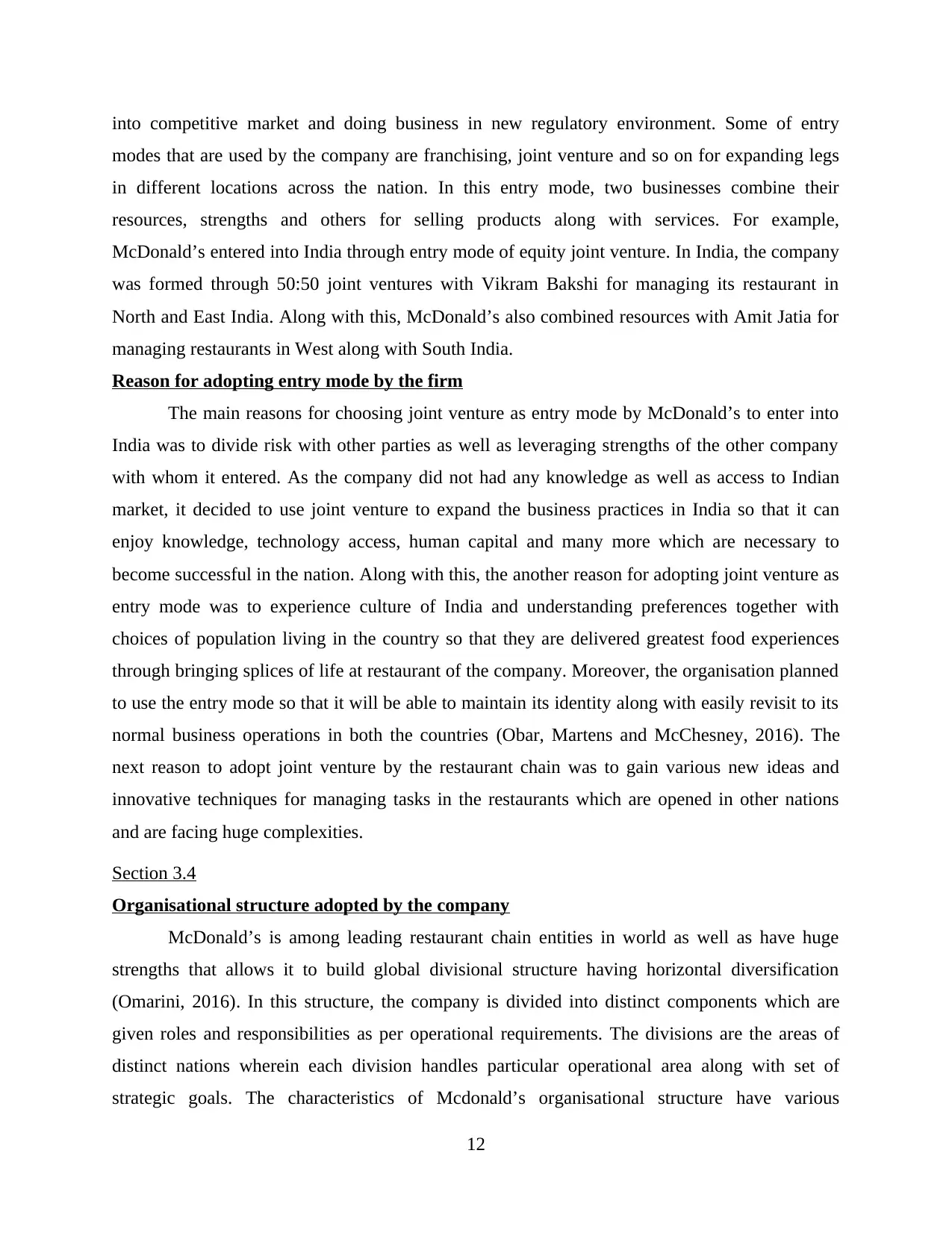
into competitive market and doing business in new regulatory environment. Some of entry
modes that are used by the company are franchising, joint venture and so on for expanding legs
in different locations across the nation. In this entry mode, two businesses combine their
resources, strengths and others for selling products along with services. For example,
McDonald’s entered into India through entry mode of equity joint venture. In India, the company
was formed through 50:50 joint ventures with Vikram Bakshi for managing its restaurant in
North and East India. Along with this, McDonald’s also combined resources with Amit Jatia for
managing restaurants in West along with South India.
Reason for adopting entry mode by the firm
The main reasons for choosing joint venture as entry mode by McDonald’s to enter into
India was to divide risk with other parties as well as leveraging strengths of the other company
with whom it entered. As the company did not had any knowledge as well as access to Indian
market, it decided to use joint venture to expand the business practices in India so that it can
enjoy knowledge, technology access, human capital and many more which are necessary to
become successful in the nation. Along with this, the another reason for adopting joint venture as
entry mode was to experience culture of India and understanding preferences together with
choices of population living in the country so that they are delivered greatest food experiences
through bringing splices of life at restaurant of the company. Moreover, the organisation planned
to use the entry mode so that it will be able to maintain its identity along with easily revisit to its
normal business operations in both the countries (Obar, Martens and McChesney, 2016). The
next reason to adopt joint venture by the restaurant chain was to gain various new ideas and
innovative techniques for managing tasks in the restaurants which are opened in other nations
and are facing huge complexities.
Section 3.4
Organisational structure adopted by the company
McDonald’s is among leading restaurant chain entities in world as well as have huge
strengths that allows it to build global divisional structure having horizontal diversification
(Omarini, 2016). In this structure, the company is divided into distinct components which are
given roles and responsibilities as per operational requirements. The divisions are the areas of
distinct nations wherein each division handles particular operational area along with set of
strategic goals. The characteristics of Mcdonald’s organisational structure have various
12
modes that are used by the company are franchising, joint venture and so on for expanding legs
in different locations across the nation. In this entry mode, two businesses combine their
resources, strengths and others for selling products along with services. For example,
McDonald’s entered into India through entry mode of equity joint venture. In India, the company
was formed through 50:50 joint ventures with Vikram Bakshi for managing its restaurant in
North and East India. Along with this, McDonald’s also combined resources with Amit Jatia for
managing restaurants in West along with South India.
Reason for adopting entry mode by the firm
The main reasons for choosing joint venture as entry mode by McDonald’s to enter into
India was to divide risk with other parties as well as leveraging strengths of the other company
with whom it entered. As the company did not had any knowledge as well as access to Indian
market, it decided to use joint venture to expand the business practices in India so that it can
enjoy knowledge, technology access, human capital and many more which are necessary to
become successful in the nation. Along with this, the another reason for adopting joint venture as
entry mode was to experience culture of India and understanding preferences together with
choices of population living in the country so that they are delivered greatest food experiences
through bringing splices of life at restaurant of the company. Moreover, the organisation planned
to use the entry mode so that it will be able to maintain its identity along with easily revisit to its
normal business operations in both the countries (Obar, Martens and McChesney, 2016). The
next reason to adopt joint venture by the restaurant chain was to gain various new ideas and
innovative techniques for managing tasks in the restaurants which are opened in other nations
and are facing huge complexities.
Section 3.4
Organisational structure adopted by the company
McDonald’s is among leading restaurant chain entities in world as well as have huge
strengths that allows it to build global divisional structure having horizontal diversification
(Omarini, 2016). In this structure, the company is divided into distinct components which are
given roles and responsibilities as per operational requirements. The divisions are the areas of
distinct nations wherein each division handles particular operational area along with set of
strategic goals. The characteristics of Mcdonald’s organisational structure have various
12
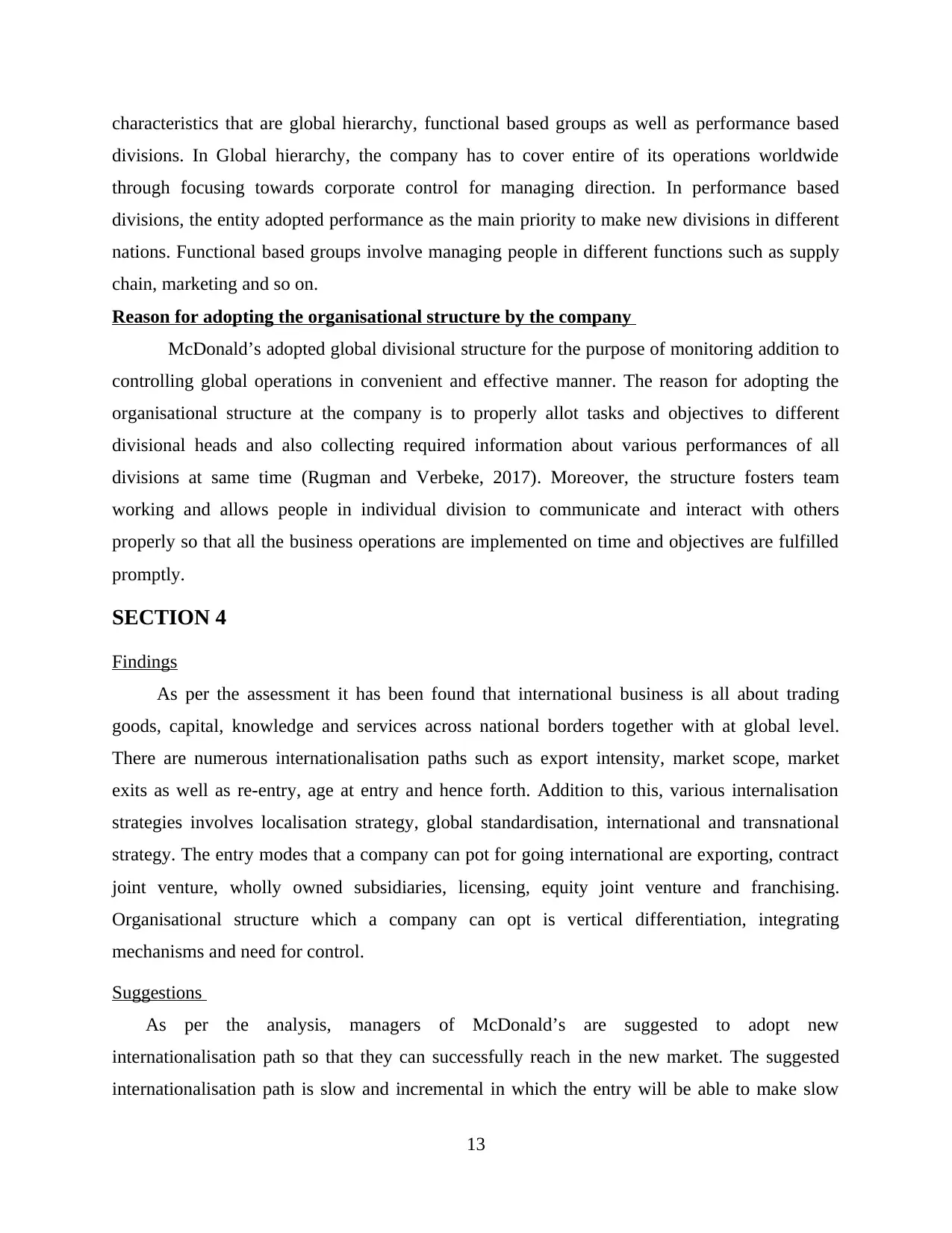
characteristics that are global hierarchy, functional based groups as well as performance based
divisions. In Global hierarchy, the company has to cover entire of its operations worldwide
through focusing towards corporate control for managing direction. In performance based
divisions, the entity adopted performance as the main priority to make new divisions in different
nations. Functional based groups involve managing people in different functions such as supply
chain, marketing and so on.
Reason for adopting the organisational structure by the company
McDonald’s adopted global divisional structure for the purpose of monitoring addition to
controlling global operations in convenient and effective manner. The reason for adopting the
organisational structure at the company is to properly allot tasks and objectives to different
divisional heads and also collecting required information about various performances of all
divisions at same time (Rugman and Verbeke, 2017). Moreover, the structure fosters team
working and allows people in individual division to communicate and interact with others
properly so that all the business operations are implemented on time and objectives are fulfilled
promptly.
SECTION 4
Findings
As per the assessment it has been found that international business is all about trading
goods, capital, knowledge and services across national borders together with at global level.
There are numerous internationalisation paths such as export intensity, market scope, market
exits as well as re-entry, age at entry and hence forth. Addition to this, various internalisation
strategies involves localisation strategy, global standardisation, international and transnational
strategy. The entry modes that a company can pot for going international are exporting, contract
joint venture, wholly owned subsidiaries, licensing, equity joint venture and franchising.
Organisational structure which a company can opt is vertical differentiation, integrating
mechanisms and need for control.
Suggestions
As per the analysis, managers of McDonald’s are suggested to adopt new
internationalisation path so that they can successfully reach in the new market. The suggested
internationalisation path is slow and incremental in which the entry will be able to make slow
13
divisions. In Global hierarchy, the company has to cover entire of its operations worldwide
through focusing towards corporate control for managing direction. In performance based
divisions, the entity adopted performance as the main priority to make new divisions in different
nations. Functional based groups involve managing people in different functions such as supply
chain, marketing and so on.
Reason for adopting the organisational structure by the company
McDonald’s adopted global divisional structure for the purpose of monitoring addition to
controlling global operations in convenient and effective manner. The reason for adopting the
organisational structure at the company is to properly allot tasks and objectives to different
divisional heads and also collecting required information about various performances of all
divisions at same time (Rugman and Verbeke, 2017). Moreover, the structure fosters team
working and allows people in individual division to communicate and interact with others
properly so that all the business operations are implemented on time and objectives are fulfilled
promptly.
SECTION 4
Findings
As per the assessment it has been found that international business is all about trading
goods, capital, knowledge and services across national borders together with at global level.
There are numerous internationalisation paths such as export intensity, market scope, market
exits as well as re-entry, age at entry and hence forth. Addition to this, various internalisation
strategies involves localisation strategy, global standardisation, international and transnational
strategy. The entry modes that a company can pot for going international are exporting, contract
joint venture, wholly owned subsidiaries, licensing, equity joint venture and franchising.
Organisational structure which a company can opt is vertical differentiation, integrating
mechanisms and need for control.
Suggestions
As per the analysis, managers of McDonald’s are suggested to adopt new
internationalisation path so that they can successfully reach in the new market. The suggested
internationalisation path is slow and incremental in which the entry will be able to make slow
13
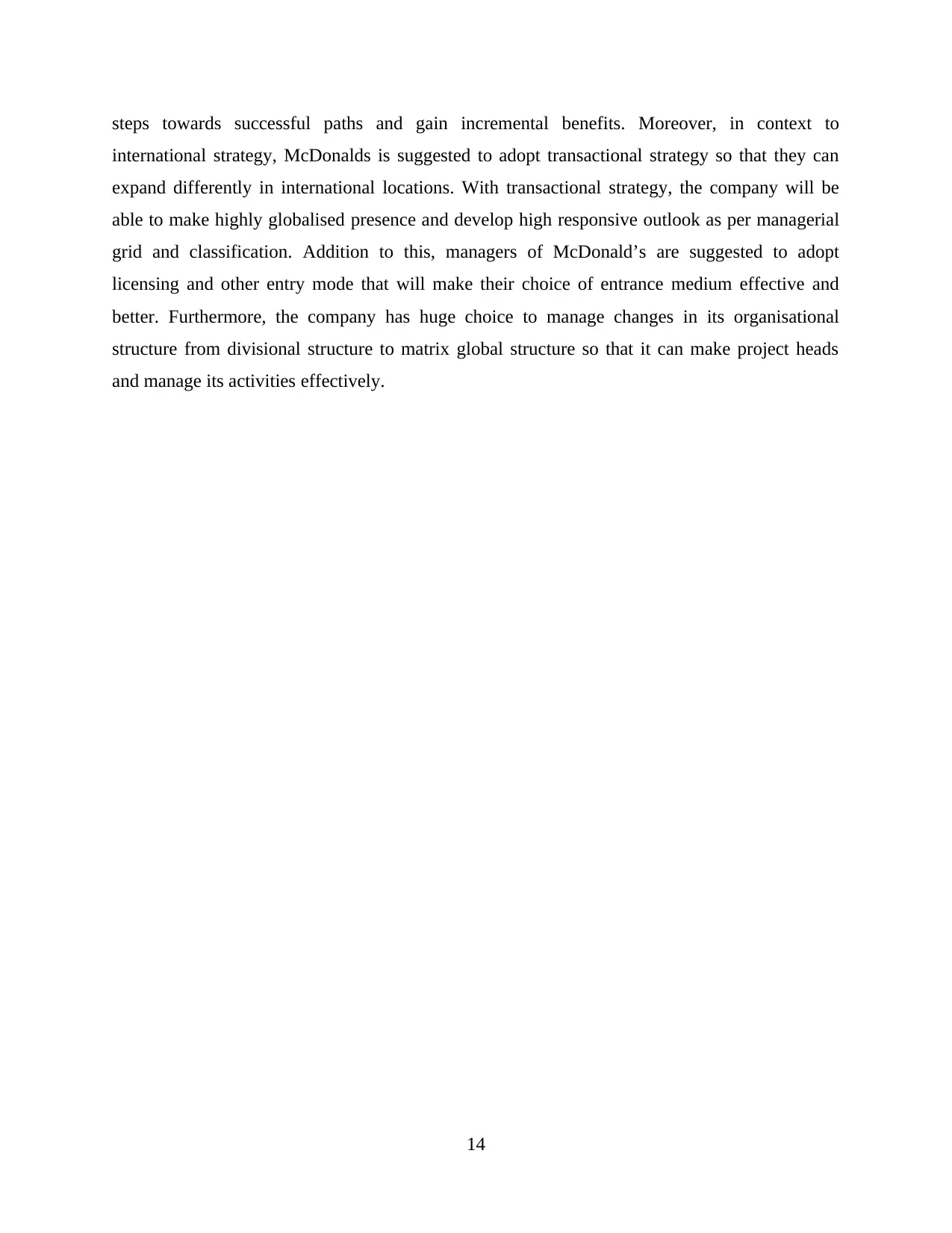
steps towards successful paths and gain incremental benefits. Moreover, in context to
international strategy, McDonalds is suggested to adopt transactional strategy so that they can
expand differently in international locations. With transactional strategy, the company will be
able to make highly globalised presence and develop high responsive outlook as per managerial
grid and classification. Addition to this, managers of McDonald’s are suggested to adopt
licensing and other entry mode that will make their choice of entrance medium effective and
better. Furthermore, the company has huge choice to manage changes in its organisational
structure from divisional structure to matrix global structure so that it can make project heads
and manage its activities effectively.
14
international strategy, McDonalds is suggested to adopt transactional strategy so that they can
expand differently in international locations. With transactional strategy, the company will be
able to make highly globalised presence and develop high responsive outlook as per managerial
grid and classification. Addition to this, managers of McDonald’s are suggested to adopt
licensing and other entry mode that will make their choice of entrance medium effective and
better. Furthermore, the company has huge choice to manage changes in its organisational
structure from divisional structure to matrix global structure so that it can make project heads
and manage its activities effectively.
14
Secure Best Marks with AI Grader
Need help grading? Try our AI Grader for instant feedback on your assignments.
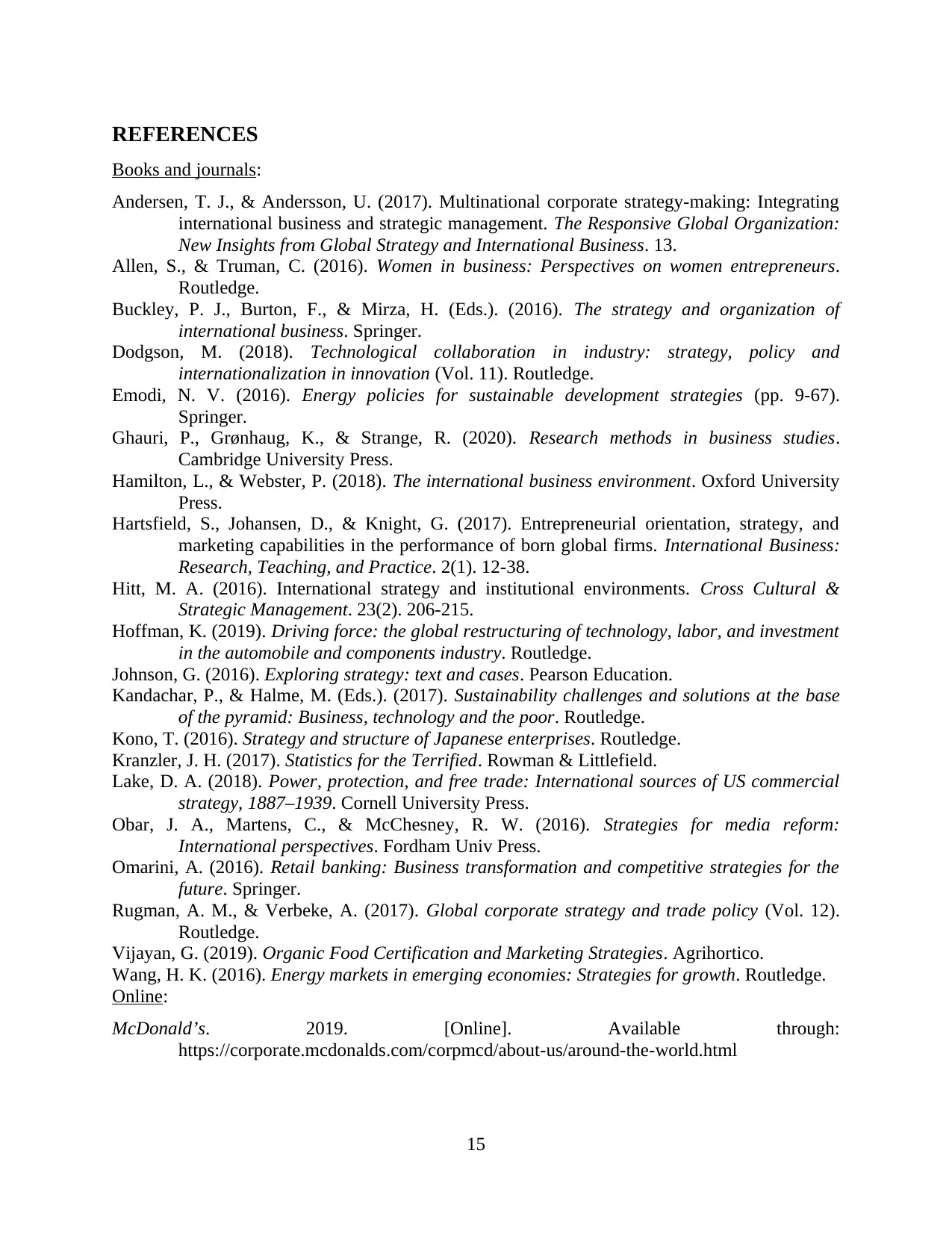
REFERENCES
Books and journals:
Andersen, T. J., & Andersson, U. (2017). Multinational corporate strategy-making: Integrating
international business and strategic management. The Responsive Global Organization:
New Insights from Global Strategy and International Business. 13.
Allen, S., & Truman, C. (2016). Women in business: Perspectives on women entrepreneurs.
Routledge.
Buckley, P. J., Burton, F., & Mirza, H. (Eds.). (2016). The strategy and organization of
international business. Springer.
Dodgson, M. (2018). Technological collaboration in industry: strategy, policy and
internationalization in innovation (Vol. 11). Routledge.
Emodi, N. V. (2016). Energy policies for sustainable development strategies (pp. 9-67).
Springer.
Ghauri, P., Grønhaug, K., & Strange, R. (2020). Research methods in business studies.
Cambridge University Press.
Hamilton, L., & Webster, P. (2018). The international business environment. Oxford University
Press.
Hartsfield, S., Johansen, D., & Knight, G. (2017). Entrepreneurial orientation, strategy, and
marketing capabilities in the performance of born global firms. International Business:
Research, Teaching, and Practice. 2(1). 12-38.
Hitt, M. A. (2016). International strategy and institutional environments. Cross Cultural &
Strategic Management. 23(2). 206-215.
Hoffman, K. (2019). Driving force: the global restructuring of technology, labor, and investment
in the automobile and components industry. Routledge.
Johnson, G. (2016). Exploring strategy: text and cases. Pearson Education.
Kandachar, P., & Halme, M. (Eds.). (2017). Sustainability challenges and solutions at the base
of the pyramid: Business, technology and the poor. Routledge.
Kono, T. (2016). Strategy and structure of Japanese enterprises. Routledge.
Kranzler, J. H. (2017). Statistics for the Terrified. Rowman & Littlefield.
Lake, D. A. (2018). Power, protection, and free trade: International sources of US commercial
strategy, 1887–1939. Cornell University Press.
Obar, J. A., Martens, C., & McChesney, R. W. (2016). Strategies for media reform:
International perspectives. Fordham Univ Press.
Omarini, A. (2016). Retail banking: Business transformation and competitive strategies for the
future. Springer.
Rugman, A. M., & Verbeke, A. (2017). Global corporate strategy and trade policy (Vol. 12).
Routledge.
Vijayan, G. (2019). Organic Food Certification and Marketing Strategies. Agrihortico.
Wang, H. K. (2016). Energy markets in emerging economies: Strategies for growth. Routledge.
Online:
McDonald’s. 2019. [Online]. Available through:
https://corporate.mcdonalds.com/corpmcd/about-us/around-the-world.html
15
Books and journals:
Andersen, T. J., & Andersson, U. (2017). Multinational corporate strategy-making: Integrating
international business and strategic management. The Responsive Global Organization:
New Insights from Global Strategy and International Business. 13.
Allen, S., & Truman, C. (2016). Women in business: Perspectives on women entrepreneurs.
Routledge.
Buckley, P. J., Burton, F., & Mirza, H. (Eds.). (2016). The strategy and organization of
international business. Springer.
Dodgson, M. (2018). Technological collaboration in industry: strategy, policy and
internationalization in innovation (Vol. 11). Routledge.
Emodi, N. V. (2016). Energy policies for sustainable development strategies (pp. 9-67).
Springer.
Ghauri, P., Grønhaug, K., & Strange, R. (2020). Research methods in business studies.
Cambridge University Press.
Hamilton, L., & Webster, P. (2018). The international business environment. Oxford University
Press.
Hartsfield, S., Johansen, D., & Knight, G. (2017). Entrepreneurial orientation, strategy, and
marketing capabilities in the performance of born global firms. International Business:
Research, Teaching, and Practice. 2(1). 12-38.
Hitt, M. A. (2016). International strategy and institutional environments. Cross Cultural &
Strategic Management. 23(2). 206-215.
Hoffman, K. (2019). Driving force: the global restructuring of technology, labor, and investment
in the automobile and components industry. Routledge.
Johnson, G. (2016). Exploring strategy: text and cases. Pearson Education.
Kandachar, P., & Halme, M. (Eds.). (2017). Sustainability challenges and solutions at the base
of the pyramid: Business, technology and the poor. Routledge.
Kono, T. (2016). Strategy and structure of Japanese enterprises. Routledge.
Kranzler, J. H. (2017). Statistics for the Terrified. Rowman & Littlefield.
Lake, D. A. (2018). Power, protection, and free trade: International sources of US commercial
strategy, 1887–1939. Cornell University Press.
Obar, J. A., Martens, C., & McChesney, R. W. (2016). Strategies for media reform:
International perspectives. Fordham Univ Press.
Omarini, A. (2016). Retail banking: Business transformation and competitive strategies for the
future. Springer.
Rugman, A. M., & Verbeke, A. (2017). Global corporate strategy and trade policy (Vol. 12).
Routledge.
Vijayan, G. (2019). Organic Food Certification and Marketing Strategies. Agrihortico.
Wang, H. K. (2016). Energy markets in emerging economies: Strategies for growth. Routledge.
Online:
McDonald’s. 2019. [Online]. Available through:
https://corporate.mcdonalds.com/corpmcd/about-us/around-the-world.html
15
1 out of 17
Related Documents
Your All-in-One AI-Powered Toolkit for Academic Success.
+13062052269
info@desklib.com
Available 24*7 on WhatsApp / Email
![[object Object]](/_next/static/media/star-bottom.7253800d.svg)
Unlock your academic potential
© 2024 | Zucol Services PVT LTD | All rights reserved.





